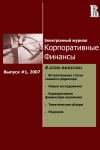Practical application of Harvard Business School approach to the company acting in unstable economic environment
Abstract
This study questions whether optimal capital structure can be determined with the use of HBS model in volatile capitalmarkets. While HBS model have assumes the target optimal capital structure inthe long-run, it ignores certain problems that arise from short-termfluctuations in capital markets, such as lack of liquidity and sharp increaseof interest rates.Therefore a company will maximize its value inthe long-run while avoiding possibility of going bankrupt and financialinstability in the short-run unfavorable economic conditions. In accordancewith that task we suggest that HBS model should be extended into two-periodmodel, where the first period represents instable financial conditions and thesecond period represents stable long-run perspective.The main part of the article describes the HBSmodel starting from assessing value of debt and value of equity and goingforward with estimation of optimal capital structure.Subsequent part provides an application ofdescribed model to actual Russian telecom company Vimpelkom as well as contrastsresulting from comparison of outputs, obtained with the use of other valuationmodels such as two-period DCF, APV and others. The final part describes authors’ view on thefuture research in the area including improvement of model’s assumptions andprovision of recommendations for industry specific analysis. The conclusion of the article states that HBSmodel with appropriate modification may provide a reasonable correction forvolatile conditions of capital markets; however more evidence of this hypothesisis required.

